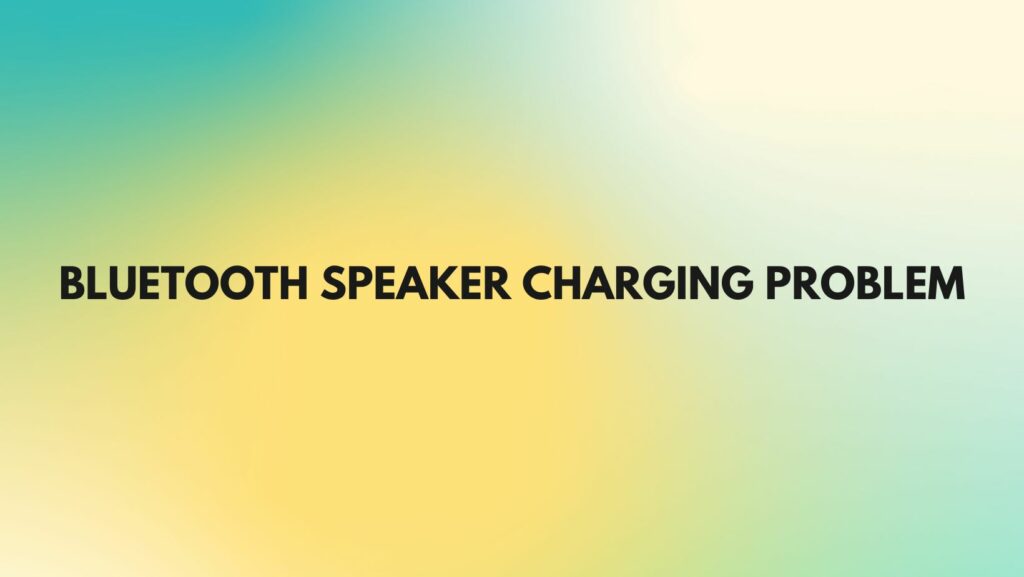Bluetooth speakers have become an integral part of our daily lives, providing us with a convenient and portable way to enjoy our favorite music, podcasts, and audiobooks. However, even the most reliable Bluetooth speakers can encounter charging problems, leaving you without your favorite tunes. This article delves into the common causes of Bluetooth speaker charging issues and provides a step-by-step guide to troubleshooting and resolving them.
Understanding the Causes of Bluetooth Speaker Charging Issues
Several factors can contribute to charging problems with Bluetooth speakers. Here are some of the most common culprits:
-
Faulty Charging Cable: The charging cable is often the first suspect when a Bluetooth speaker fails to charge. Over time, the cable can become frayed or damaged, preventing proper power transfer to the speaker.
-
Incorrect Power Source: Ensure you’re using a power source that meets the speaker’s power requirements. Using a low-power adapter or a faulty USB port may not provide sufficient power for charging.
-
Dirty Charging Port: The charging port on the speaker can accumulate dust and debris over time, hindering the connection with the charging cable.
-
Software Issues: In some cases, software glitches or outdated firmware can cause charging issues. Updating the speaker’s firmware to the latest version may resolve the problem.
-
Damaged Battery: In rare instances, the battery itself may be damaged or faulty, preventing it from holding a charge. This is more likely to occur if the speaker has been subjected to extreme temperatures or mishandling.
Troubleshooting Steps to Fix Bluetooth Speaker Charging Problems
Before resorting to contacting the speaker manufacturer’s customer support, try these troubleshooting steps to resolve charging issues with your Bluetooth speaker:
-
Inspect the Charging Cable: Carefully examine the charging cable for any signs of damage, such as frayed wires, exposed connectors, or bent pins. If the cable is damaged, replace it with a new one.
-
Test Different Power Sources: Connect the speaker to different power sources, such as a wall outlet, a computer USB port, or a power bank. If the speaker charges with a different power source, the issue likely lies with the original power source.
-
Clean the Charging Port: Use a soft brush or cotton swab to gently clean the charging port on the speaker, removing any accumulated dust or debris. Avoid using sharp or abrasive objects that could damage the port.
-
Update Speaker Firmware: Check for available firmware updates for your speaker. Download and install the latest firmware version, as it may address known charging-related issues. Consult the speaker’s user manual for specific instructions on updating firmware.
-
Reset the Speaker: Performing a factory reset on the speaker can sometimes eliminate software glitches or corrupted settings that may be causing charging problems. Refer to the user manual for specific instructions on resetting your speaker model.
-
Check the Charging Indicator: If the speaker has a charging indicator light, observe its behavior while charging. A steady light usually indicates proper charging, while a blinking light or no light at all may signal a charging issue.
Preventive Measures to Avoid Future Charging Problems
To minimize the risk of charging issues in the future, follow these preventive measures:
-
Use the Original Charging Cable: Whenever possible, use the original charging cable or a high-quality compatible one to ensure proper power delivery and prevent potential damage to the battery.
-
Protect from Extreme Temperatures: Avoid exposing the speaker to extreme heat or cold, as these conditions can affect battery performance and shorten its lifespan.
-
Store the Speaker Properly: When not in use, store the speaker in a cool, dry place to protect the battery from extreme temperatures and humidity.
-
Handle with Care: Avoid dropping, mishandling, or subjecting the speaker to physical stress, as this can damage internal components, including the battery.
-
Monitor Charging Process: Keep an eye on the charging indicator light or monitor the charging status through the speaker’s app (if available) to ensure the speaker is charging properly. If the light remains on indefinitely or exhibits unusual behavior, unplug the speaker and consult the user manual or contact the manufacturer’s customer support.
Conclusion
By understanding the common causes of Bluetooth speaker charging issues and following the troubleshooting steps provided, you can effectively resolve charging problems and keep your favorite tunes at your fingertips. Prioritize safe charging practices, maintain the speaker properly, and contact the manufacturer’s customer support if the issue persists. With proper care and attention, you can enjoy your Bluetooth speaker for many years to come.


